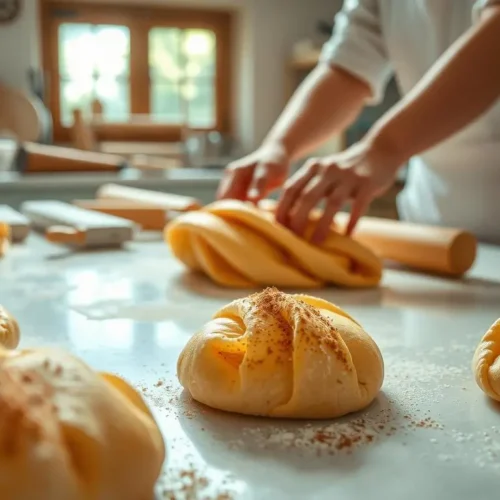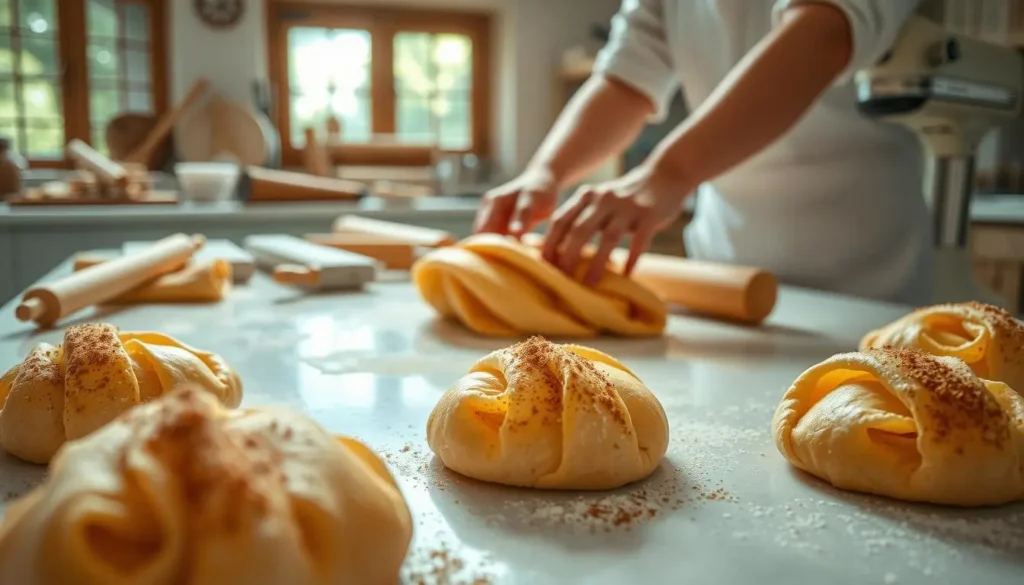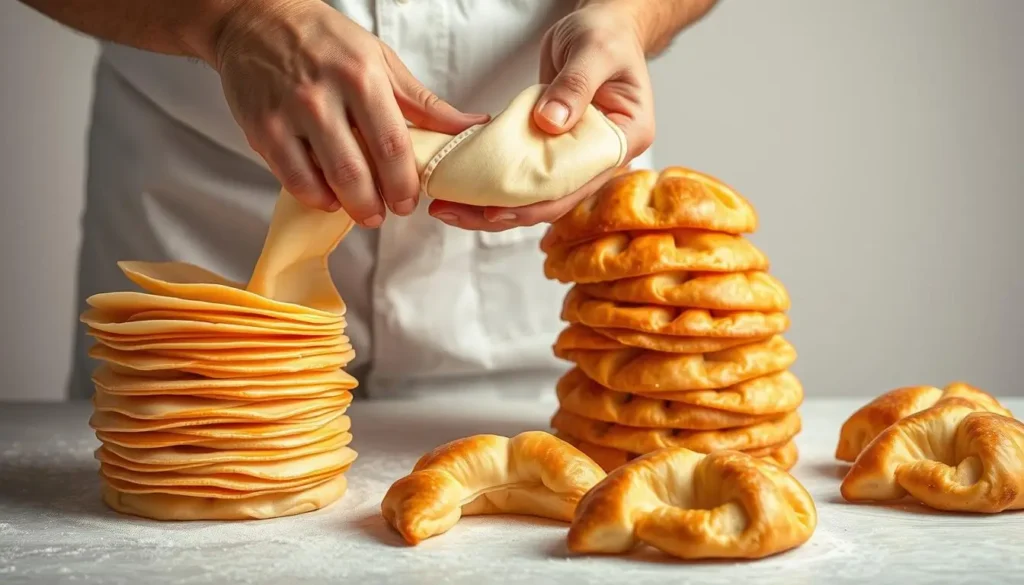Table of Contents
The first time I tried a Swiss butter croissant, it changed my baking forever. The flaky texture and buttery taste took me to a Swiss bakery. It sparked a love for making these amazing breakfast treats.
I’ve spent hours perfecting Swiss breakfast pastries. My journey with gipfeli recipe has been full of learning. These pastries are special, like French croissants but uniquely Swiss.
In this guide, I’ll share all I’ve learned about making perfect gipfeli. You’ll learn about their cultural background and how to laminate the dough. Soon, you’ll be making bakery-quality pastries at home.
Key Takeaways
- Learn the authentic Swiss technique for creating perfect gipfeli
- Understand the cultural significance of this beloved breakfast pastry
- Master the art of buttery, flaky dough lamination
- Discover professional baking tips for consistent results
- Create restaurant-quality Swiss butter croissants at home
The History and Heritage of Swiss Gipfeli
Swiss baking tradition is special, with the traditional gipfeli recipe being a cultural treasure. These tasty pastries have been a Swiss breakfast favorite for years. They show the skill of Swiss bakers.
Origins in Swiss Baking Tradition
The swiss crescent roll has a long history, starting in the early 19th century. Swiss bakers created a unique pastry that became a national favorite. Unlike other European pastries, gipfeli have their own special taste and texture.
- Originated in Swiss bakeries in the 1800s
- Developed as a local variation of European pastry techniques
- Perfected by generations of Swiss bakers
Distinguishing Gipfeli from French Croissants
Exploring the difference between a croissant and a gipfeli reveals some key differences. Both are crescent-shaped, but gipfeli have a unique quality that makes them different from French croissants.
| Characteristic | Gipfeli | Croissant |
|---|---|---|
| Sweetness | Slightly sweeter | Less sweet |
| Texture | Softer, more tender | Crispier, more flaky |
| Butter Content | Moderate | High |
Cultural Significance in Swiss Breakfast
Gipfeli are more than just a pastry; they are a part of Swiss morning culture. Families and friends enjoy these crescents with coffee or tea. It’s a time for connection and tradition.
Each bite shares a story of Swiss culinary skill, passed down through generations. The gipfeli recipe symbolizes Swiss hospitality and baking excellence.
Essential Ingredients for Authentic Gipfeli Recipe
Making the perfect gipfeli recipe begins with choosing top-notch ingredients. The secret to authentic Swiss pastry is in the ingredients. The right mix can turn your baking into something truly special.

The Best Gipfeli Recipe
Equipment
- Mixing Bowls – For dough preparation.
- Rolling Pin – For rolling out the dough and butter.
- Baking Sheet – For baking the Gipfeli.
- Parchment Paper – To prevent sticking.
- Pastry Brush – For applying the egg wash.
- Sharp Knife or Pizza Cutter – For cutting dough into triangles.
- Measuring Cups & Spoons – For accurate ingredient portions.
Ingredients
For the Dough:
- 2 cups all-purpose flour
- 1 tablespoon granulated sugar
- 1 teaspoon salt
- 1 teaspoon active dry yeast
- ½ cup warm milk 110°F/45°C
- 3 tablespoons unsalted butter softened
- 1 egg yolk
- ½ teaspoon vanilla extract optional for a sweet version
For the Butter Layers:
- ½ cup unsalted butter cold
- ¼ cup all-purpose flour for dusting
For the Egg Wash:
- 1 egg yolk
- 1 tablespoon milk
Instructions
Step 1: Prepare the Dough
- In a small bowl, mix warm milk, yeast, and sugar. Let sit for 5 minutes until foamy.
- In a large bowl, combine flour and salt.
- Add yeast mixture, egg yolk, vanilla extract (if using), and softened butter.
- Knead dough for 8-10 minutes, until smooth and elastic.
- Cover and let rise for 1 hour, or until doubled in size.
Step 2: Prepare the Butter Layer
- Place cold butter between two sheets of parchment paper. Roll out into a thin rectangle (about 6×6 inches).
- Chill in the fridge while the dough rises.
Step 3: Laminate the Dough
- Roll out the dough into a 12×12-inch square on a floured surface.
- Place butter layer in the center and fold the dough over it like an envelope.
- Roll out gently into a rectangle, then fold into thirds.
- Repeat this process two more times, chilling between folds if needed.
Step 4: Shape the Gipfeli
- Roll the dough into a large circle (~¼ inch thick).
- Cut into 8-10 triangular pieces.
- Roll each triangle from the wide end to the tip, forming a crescent shape.
- Place on a lined baking sheet and let rise for 30 minutes.
Step 5: Bake
- Preheat oven to 375°F (190°C).
- Brush each Gipfeli with egg wash.
- Bake for 18-20 minutes, or until golden brown.
Step 6: Serve
- Let cool for 5 minutes before serving.
- Enjoy plain or with jam, honey, or chocolate spread.
Notes
- Calories: ~280 kcal
- Protein: ~5g
- Carbohydrates: ~30g
- Fiber: ~1g
- Sugar: ~4g
- Fat: ~15g
- Saturated Fat: ~9g
- Sodium: ~200mg
- Cholesterol: ~60mg
Let’s explore the key ingredients that make gipfeli stand out. The most important ones are:
- High-protein bread flour: This is key for the flaky texture
- European-style unsalted butter with high butterfat content
- Fresh eggs for binding and richness
- Active dry yeast for proper rising
- Cold water or milk
Gipfeli and croissants share many ingredients. But, gipfeli have a special butter-to-flour ratio and folding method. This makes them unique.
| Ingredient | Purpose | Recommended Type |
|---|---|---|
| Flour | Structure and texture | King Arthur Bread Flour (12-14% protein) |
| Butter | Flakiness and flavor | European-style unsalted butter (82% butterfat) |
| Yeast | Leavening | Fresh active dry yeast |
For croissants and gipfeli, bakers say high-protein bread flour is best. It gives the dough the strength and stretch needed for those layers. These layers make the pastries so tempting.
Professional Baker’s Tips for Perfect Gipfeli Recipe Dough
Making great gipfeli dough needs skill and precision. As a dedicated baker, I’ve found that perfecting pastry takes time and learning key techniques. The key to a great croissant is balancing ingredients and method carefully.
Mastering the Lamination Process
The lamination process is key for flaky layers in your gipfeli recipe dough. I’ll share my expert croissant recipe tips for perfect results every time.
- Start with cold butter (around 55°F)
- Roll the dough to an even thickness
- Create precise butter blocks for consistent layering
- Use a bench scraper for clean edges
Temperature Control Techniques
Keeping the right temperature is vital when working with gipfeli dough. The temperature affects butter consistency and dough elasticity.
| Temperature Range | Dough Behavior | Recommended Action |
|---|---|---|
| Below 50°F | Butter too hard | Let dough rest briefly |
| 55-60°F | Ideal butter consistency | Continue lamination |
| Above 65°F | Butter becomes greasy | Refrigerate immediately |
Proper Dough Hydration
Hydration is crucial for perfect gipfeli dough. The right moisture content affects texture and flavor. I suggest using high-protein flour and measuring liquids carefully for the best results.
- Use cool water or milk
- Mix until just combined
- Allow dough to rest and absorb moisture
- Avoid overworking the dough
By using these professional techniques, you can make gipfeli at home that’s as good as those from top bakeries.
Step-by-Step Gipfeli Recipe
Making the perfect simple gipfeli recipe needs care and patience. I’ll show you how to make an easy gipfeli recipe. It brings Swiss bakery magic to your kitchen. This recipe will improve your baking skills with Swiss techniques.

- 500g high-protein bread flour
- 10g active dry yeast
- 250ml cold milk
- 50g sugar
- 250g unsalted butter (for lamination)
- 1 egg (for egg wash)
The secret to a real gipfeli recipe is mastering lamination. I’ll teach you how to make those flaky layers. These layers make Swiss pastries truly special.
- Activate the yeast in warm milk
- Mix dry ingredients thoroughly
- Create a smooth, elastic dough
- Chill the dough for 1 hour
- Roll and fold butter into multiple layers
My BBC-inspired gipfeli recipe emphasizes temperature control. Keep your butter cold but soft – around 50°F is ideal. This helps create delicate, buttery layers.
| Stage | Temperature | Duration |
|---|---|---|
| Initial Mixing | 60-65°F | 15 minutes |
| Lamination | 50°F | 30 minutes |
| Final Proofing | 75-80°F | 45 minutes |
Are you ready to improve your baking? With practice, you’ll make gipfeli as good as any Swiss bakery!
Mastering the Art of Dough Folding and Shaping
Making perfect gipfeli needs precision and skill, mainly in dough folding and shaping. As a passionate baker of swiss pastry recipes, I’ll share secrets for those iconic crescent-shaped delights. They will make your easy croissant recipe stand out.
The magic of great gipfeli is in the delicate art of folding and shaping. Professional bakers know that technique is key. It turns an ordinary pastry into an extraordinary one.
Creating the Perfect Crescent Shape
To get the classic crescent shape, follow these steps:
- Roll the dough into a perfect triangle
- Stretch the base of the triangle slightly
- Start rolling from the wide end towards the point
- Gently curve the ends to create the signature crescent
Achieving Multiple Flaky Layers
Flakiness is key in swiss pastry recipes. The secret is in the lamination process:
- Fold butter into the dough carefully
- Create multiple turns with 30-minute resting periods
- Maintain consistent cold dough temperature
Common Shaping Mistakes to Avoid
| Mistake | Solution |
|---|---|
| Overworking the dough | Handle gently, minimal manipulation |
| Uneven thickness | Use consistent rolling techniques |
| Warm dough | Keep dough chilled between steps |
With practice, your easy croissant recipe will become professional-quality gipfeli. They will impress family and friends alike!
Baking Techniques for Golden-Brown Perfection

To get the perfect golden-brown gipfeli, you need precision and skill. I’ll share some expert techniques to make your home baking look like a pro’s.
The key to great gipfeli recipe baking is knowing your oven well. Keeping the temperature right is key for flaky pastries. Preheat your oven to 400°F (204°C) for the best results.
- Use an oven thermometer to ensure accurate temperature
- Place gipfeli on a parchment-lined baking sheet
- Leave enough space between pastries for even baking
Steam is a game-changer in gipfeli baking. It helps create a glossy, golden-brown crust. Try placing a small pan of hot water on the bottom rack to add moisture.
For a shiny finish, use an egg wash. Brush the gipfeli with a mix of beaten egg and milk before baking. This simple trick makes your treats look professional.
Baking time is usually 15-20 minutes. Keep an eye on them in the last few minutes to avoid over-browning. The ideal gipfeli is golden, crispy, and flaky.
Storage and Reheating Guidelines
After making your tasty gipfeli, it’s key to store them right. This keeps their flaky texture and flavor. You need to be careful to keep them crisp on the outside and soft inside.
Preserving Your Fresh Pastries
For storing gipfeli, use an airtight container. This keeps them away from moisture and helps them stay fresh. Room temperature storage is best for up to 2 days after baking.
- Store at room temperature in a sealed container
- Keep away from direct sunlight
- Avoid humid environments
Long-Term Storage Solutions
Freezing is great for keeping your gipfeli fresh for longer. Wrap each one in plastic wrap, then put them in a freezer-safe bag. This stops freezer burn.
Reviving Your Pastries
To warm up your gipfeli, use an oven or toaster oven. Preheat to 300°F and warm for 3-5 minutes. This brings back their fresh-baked taste.
- Preheat oven to 300°F
- Place gipfeli on a baking sheet
- Warm for 3-5 minutes
- Enjoy your freshly restored pastry
Pro tip: Avoid microwaving, as it can make your gipfeli soggy and compromise their delicate layers.
Troubleshooting Common Gipfeli Problems
Baking gipfeli can be tricky. Many home bakers wonder if croissants are very unhealthy? While these pastries aren’t the most nutritious, knowing common baking challenges can help you make delicious treats.
Let’s look at some typical gipfeli problems and their solutions:
- Dough Won’t Rise
- Check yeast freshness
- Ensure warm (not hot) environment
- Verify water temperature
- Butter Leakage During Baking
- Keep butter cold
- Chill dough between folding
- Maintain proper lamination technique
- Dense or Dry Pastries
- Avoid overworking dough
- Use precise measurements
- Control fermentation time
When thinking about are croissants very unhealthy?, I suggest moderation. A few simple changes can make gipfeli slightly healthier:
| Modification | Nutritional Impact |
|---|---|
| Use whole wheat flour | Increased fiber |
| Reduce butter quantity | Lower fat content |
| Add seeds or nuts | More protein and nutrients |
With practice and these tips, you’ll get better at making perfect, delightful gipfeli every time!
Conclusion
Making the perfect gipfeli is an art that needs patience, practice, and passion. I’ve shown you how to make these Swiss pastries, from their cultural roots to the lamination technique. It might seem hard at first, but remember, every baker starts where you are.
Trying new things with gipfeli can be fun. As you get better, you might want to try them with different drinks. Some bakers even enjoy making mangria, a fruity wine cocktail, to go with their gipfeli at a Swiss-style breakfast.
Keep learning and don’t get discouraged by mistakes. Each batch of gipfeli makes you better at making pastries. Whether you bake at home or dream of being a pro, these Swiss treats are a great challenge.
I encourage you to share your gipfeli stories, both the good and the bad. Baking is a journey, and your experiences can inspire others to keep exploring.

